Skyjack president shares global transformation plans
13 April 2023
Skyjack’s president Ken McDougall explains the catalysts for the manufacturer to establish production facilities in Mexico and how a regional, strategically-placed factories will drive the company’s globalisation.
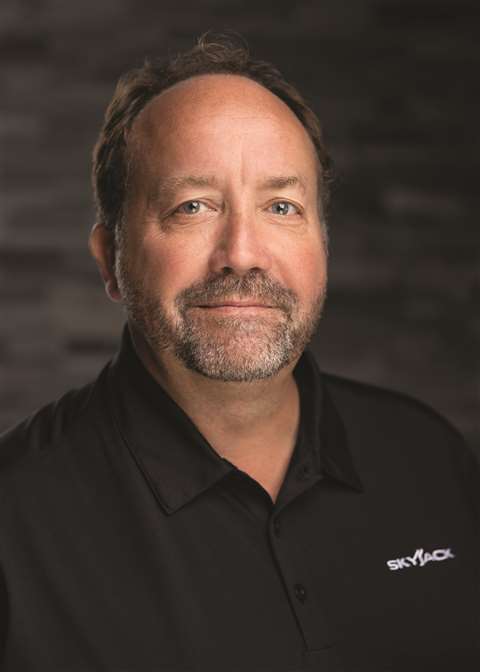 Ken McDougall, president of Skyjack. (PHOTO: Skyjack)
Ken McDougall, president of Skyjack. (PHOTO: Skyjack)
Globalisation is the name of the game for Skyjack, as the company opens a series of strategically-placed factories around the world, while promising to expand production and R&D at its headquarters in Canada.
Until recently, the manufacturer’s entire range of MEWPs and telehandlers were produced at its headquarters in Guelf, Canada. Now, new facilities in Mexico, China and Hungary are changing the manufacturer’s production footprint as it seeks to produce in or close to its international markets.
As part of the plan Skyjack now has three distinct operating groups: North America, Europe and the Asia Pacific.
As Skyjack’s president Ken McDougall explains, one of the catalysts for the Mexico plant was the Covid pandemic, leading to a tightening of the supply chain and components becoming increasingly scarce.
This was exacerbated by the ensuing tariffs on components manufactured in China brought in by the US Government.
How Skyjack plans to protect itself from future supply chain issues
The company realised that to protect itself from similar challenges in the future it must bring more protection elements in-house or source them closer to its local manufacturing facilities.
“The ITC anti-dumping really pointed to some of the larger elements that we were bringing from China, and we undertook very rapidly to re-source those, and the source location we found was in Mexico,” says McDougall.
“It played quite a role [in the decision we made] to move larger fabricated welds from China to Mexico.”
Expanding his view of the tariffs, McDougall adds, “It was disruptive for everyone. And for us, we feel we were not a Chinese MEWP manufacturer, but were kind of lumped into it.”
He adds, “There are things that still need to be sorted with this. I still see a lot of what I would call restricted machines entering Canada.
“If we look at our market, numbers in Canada have seen a massive increase, which can’t just be based on usage - it’s got to be other machines being moved here.
“I don’t know if they will end up in the US or not, but I would hope the importers - the rental companies - don’t do that as they as they will have to declare them.”
MacDougall added, “Then, when you are looking at the supply chain management being closer to home, it led us to say, ‘OK if we are doing those things already in Mexico, maybe we also build the machines closer to where the original fab is being done.’”
Phase one of the Mexico plant consists of a 200,000 sq ft facility with telehandlers and booms, with units produced there aimed at the Americas region. Phase two, which has already begun, will see 490,000 sq ft added to the plant.
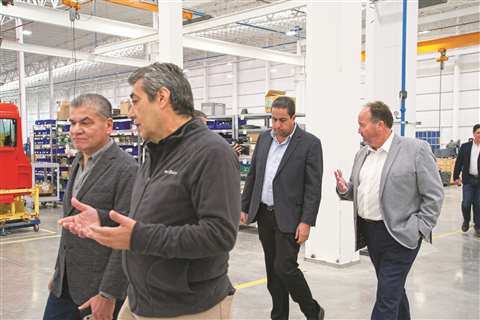 On a tour of the manufacturer’s Mexican plant. (PHOTO: Skyjack)
On a tour of the manufacturer’s Mexican plant. (PHOTO: Skyjack)
How Skyjack has expanded its production capabilities over the past year
Earlier in 2022 Skyjack announced its intentions to open manufacturing facilities in China to consist of two phases. The first units came off the production line in September 2022, marking the completion of phase one which saw the use of a 35,000 sq ft facility.
The plant, located in Tianjin, initially focused on the company’s smaller DC scissors. Phase 2, which was launched with a ground-breaking ceremony in October 2022, will result in a 400,000 sq ft facility that will focus on DC scissors and booms to be supplied to the Asia-Pacific and Australian regions.
The facility is scheduled to be in production in the third quarter of this year.
Last year also saw increased activity in Europe as Skyjack expanded in Oros, Hungary. The facility offers 113 000 sq ft of space.
Production of the New SJ45 AJ & SJ60 AJ articulating boom product started there in October and the plant is destined to supply telescopic booms, DC, and compact RT Scissors, as well as the articulating booms to Europe.
Will Skyjack protect or abandon its operations in Canada?
One of McDougall’s core messages is that production capacity in Canada will not just be protected under the ongoing plans, it will be expanded too, and become the innovation hub of the company.
“We have conversations with people in Canada, who say, ‘You’re moving - you’re leaving.
My answer is, “No, we’re not leaving, we’re growing. We’re still adding people into the Canadian organisation and will do so in the future.
MacDougall adds, “Skyjack is not abandoning its Canadian operations - it is very much a focus for us to build and grow in Canada, and by moving some of the production out it helps us focus on innovation in Canada.”
“So really, the big message is we are growing in all areas to supply in the regions for the regions. I don’t like being held hostage by our supply base, so we will try to take more control of that as we go forward.
There will still be some cross shipping but we will try to minimise freight impacts and the next time something happens we should be more self-sufficient.”
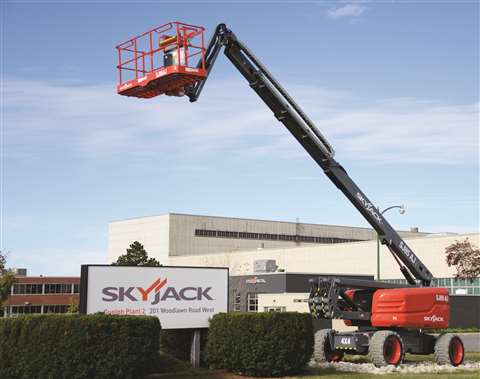 Skyjack headquarters in Guelph, Canada. (PHOTO: Skyjack)
Skyjack headquarters in Guelph, Canada. (PHOTO: Skyjack)
On the subject of exhibitions taking place during 2023, like March’s ConExpo, in Las Vegas, MacDougall says the concentration is on the expansion of the company, rather than the introduction of new products.
“We don’t have a lot of new product for the shows; we have had our hands full with capacity increases and globalisation. So really the big message is, we are growing in all areas to supply in the regions for the regions.”
Making the most of opportunities in the Chinese equipment market
China holds vast opportunities and an almost equal number of challenges for any MEWP manufacturer looking to develop in the market, which remains the fastest growing in the world and still young in terms of rental maturity.
While McDougall concedes that Skyjack has been late to the market, he believes the company may have escaped some of the pitfalls by doing so.
“We’ve had an eye on China for a very long time and looked at multiple ways to enter the market. We looked at acquisition, and a range of different ways to enter the market.
“We determined the easiest and probably the best was to maintain our identity, our DNA, and go it on our own.”
As part of that McDougall brought in Chan Tran, as vice president of the Asian Pacific region. Tran already worked for the Linamar group and brings a wealth of experience.
“It was a little painful trying to do that during Covid but we were able to identify an underutilized automotive factory in Tianjin. We now rent a portion of that, and the first scissors came off the line in November.”
The units are undergoing certification for other countries in the region, like Korea and Australia, along with CE certification to allow some of the products to be shipped to Europe.
The new 400,000 square ft facility, located directly across the road from Linamar’s established plant in China, is under construction and is set to open in the third or fourth quarter of this year. It will become the hub for the manufacturer’s manufacturing for Asia.
Further product will follow later in the year. “We do see a demand for telescopic booms more than other type of booms, so that is what we are heading towards.”
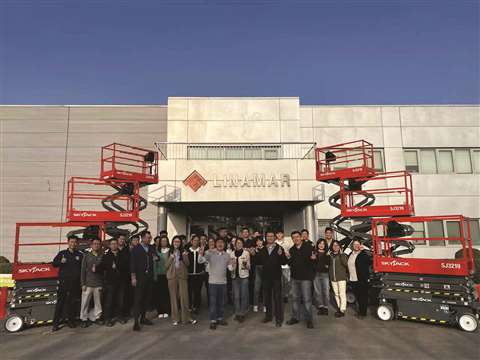 The manufacturer’s facility in China. (PHOTO: Skyjack)
The manufacturer’s facility in China. (PHOTO: Skyjack)
Why a measured approach is the best strategy
Expanding on Skyjack’s differing product directions for each region, McDougall comments, “It’s a bit different in China to the launch model for Mexico, which is producing mature product for a mature market.
“So, you’ll see a more measured and drawn-out launches in the Chinese facility, slowly adding in product there over time.”
“Our vision is, when we are successful in gaining market share in those markets, 400,000 square feet is probably too small.”
As McDougall says, the story of MEWP growth in China is one that the worldwide industry is following very closely. However, he has some reservations about the vast numbers of units entering the market.
“The numbers are strange. We have seen spikes that we’re not sure is 100% transparent from reporting point of view - did it really grow that quickly?
“We know it’s a big market that we have been underserving. I think it won’t continue to grow at the rate but I know it’s a very big market.”
One of the big questions surrounds the direction of the rental market. “We see a lot of those OEMs doing their own rental distribution that would not fly here [in North America] - what happens and how the rental industry matures is still to be determined.
“We are not getting in there with an eye of being a rental company. We are going in to do what we do best, and that’s to build quality equipment and using some of the economies of producing there to supply at a more competitive level than importing it the market.”
Why China-made equipment on the European market is on the rise
The economy in North America is looking strong. There has been talk of recession and inflation but the rental industry has come out of Covid with an aging fleet. Although the supply chain issues have not helped that concern.
The flip side of the tariff situation in the US, McDougall comments, is that there have been a significant influx of China built machines into Europe that were likely originally intended for the US.
“The companies that are restricted to selling into the US are selling into Europe. The is a challenge as the capacities we have been asked to supply are getting replaced by companies that can. We have seen a significant shift, so we have to do our job to get it back.
“The lead times are better than they were last year. But there is a lot of demand – and a lot of backlog. So, we have been growing the number of machines coming out of Hungary - two models are produced from there and there will be a third by the end of the year. And we will continue to add to that.”
There is plenty of room to grow in Hungary, and McDougall envisages that will happen.
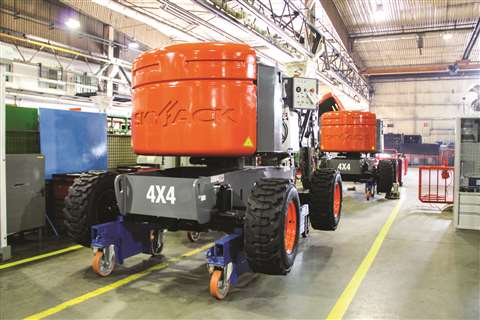 Production at Skyjack’s Hungary location. (PHOTO: Skyjack)
Production at Skyjack’s Hungary location. (PHOTO: Skyjack)
How Brexit has affected equipment manufacturing in the UK
Another challenge in Europe has come from Brexit. In the UK, where Skyjack has traditionally had its European base, the upheavals caused by the UK leaving the EU have been greater than expected.
“From our perspective,” says McDougall, “We have always had a fairly decent foothold in the UK and there’s always been more room for us in mainland Europe to grow our products.
“Brexit has been a pain, especially for a company like us that used the UK as our central distribution point for mainland Europe.
“It had us looking at other opportunities for mainland Europe.”
Asked if Skyjack plans to move its base from the UK, McDougall replies that he is still confident about the strength of the UK market.
“We may duplicate and have a secondary EU distribution point, and there are some obvious places. There are some irons in the fire.”
“But the UK operation and skill we have there is not something we will displace. “
STAY CONNECTED



Receive the information you need when you need it through our world-leading magazines, newsletters and daily briefings.
CONNECT WITH THE TEAM












